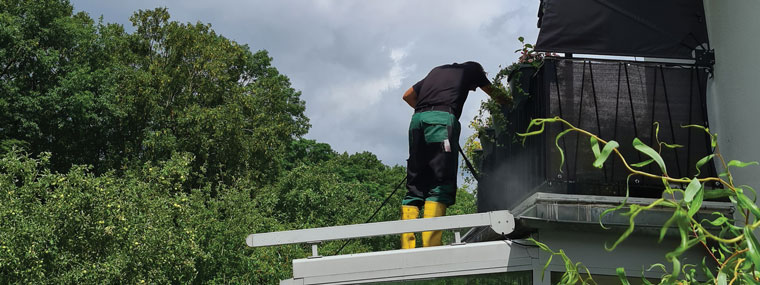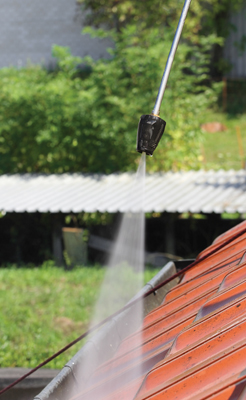
Pressure Washing and Soft Washing
Valuable Tools and a Place for Each
By Diane M. Calabrese / Published April 2022

Betadine and hydrogen peroxide are to abraded skin as soft washing is to substrates. A loose analogy, yes, but it gets us to the distinction we want to make.
Show up at a medical clinic with an abrasion or cut, and if there’s no profuse bleeding, the first goal is to clean it and do no more harm. Now, if there are embedded pebbles in a knee because of a fall on gravel, the pressure of forceps may be needed to pull them out.
But the idea with the injury is to clean it—and to protect it from infection—without damaging more skin. Similarly, soft washing uses chemicals to accomplish cleaning while bypassing pressure that could result in damage to a substrate.
Or try it another way. Soft washing and pressure washing are different. A pressure washer accomplishes its task with water under pressure. No pressure is required (in the strictest sense) to soft wash.
We walk into a thorny patch of nomenclature when we put pressure washing and soft washing side by side, and there are some little differences of perspective.
Let’s try for clarity if not complete unity on every nuance. To begin, consider some parameters familiar to most contractors in 2022.
“Any shingle roofs should never be pressure cleaned and always be soft washed,” says Stephen Venturini, the Louisiana Deco Products representative for the company based in Denver, CO. “Stucco homes are best to be soft washed, especially around windows and doors.”
Some substrates may require a consultation with their manufacturer prior to an approach. “Galvanized metal is usually not a great match for a soft wash, although it depends on the ratio of chemical used,” says Venturini.
At the same time, pressure washing and soft washing can complement each other. “Any situation that has heavy mold growth would be an ideal situation to use both techniques,” says Venturini. “Most of the time we find this happens on flatwork.”
Today, contractors should be prepared to use one or both methods. It’s a must, says Venturini. “You never know what you are going to run into when you are out on the job.”
Whichever method of cleaning is used, a property owner must be responsible for hiring a competent company, says Venturini. That means verifying that a contractor is licensed and insured.
Property owners should also ask about certifications a contractor holds. The questions asked will in turn promote professionalism across the industry. “For contractors it’s important to make sure that as a business professional you have the proper education and coverage to care for clients’ homes when dealing with chemicals and pressure,” says Venturini.
Let’s now turn to two members of our industry to learn how each one views the nexus of pressure washing and soft washing.
PWNA President
Bo Josetti, the current president of PWNA [Power Washers of North America] is the owner of All Clean Power Washing in Selbyville, DE. He is passionate about sharing his assessment of soft washing, a valuable process.
“First of all, soft washing is a process and not a piece of equipment,” says Josetti. “There is much debate about this in the industry, and I feel it’s time for me to put some facts out there on the record.” As a process, it has not been static—nor is it static now.
“This industry has evolved over the last 20 years, and it is mostly to do with the implementation of soft washing technology based on the trial and error of contractors in the industry and the changing building materials over the last 30 years,” explains Josetti. To illustrate the point, he cites the information provided by those who produce construction materials.
“When you read most of the manufacturers’ warranty information and their description of proper psi—pounds per square inch—and proper soap and chemical application, it plays right into the soft washing technology that we as an industry have formulated over the last couple of decades,” says Josetti. In other words, contractors have been refining their approach and participating in the development of what is labeled soft washing.
“The description of soft washing can be Googled and, in my opinion, is still subject for debate,” says Josetti. “But here are the facts: You do not have to have a soft wash application pump to soft wash a surface; you can in fact soft wash with a [pressure washer] while down streaming or even use a pump-up sprayer…”
And Josetti reminds us again that soft washing is a process and “not a piece of equipment” with a couple of a caveats. The caveats? “There are surfaces that will require a designated soft wash application pump to get the proper chemical ratio applied to that surface. But such pumps are not necessary for most other surfaces.”
Many dimensions of soft washing elicit different views. That includes designated soft wash application pumps. “You can debate that some of these types of pumps are more productive and can apply at higher volumes if that is what you need,” says Josetti. “But they can also be much more expensive and complicated to use, and that is a debate for another article.”
 Josetti notes that in his role as PWNA president and instructor for the organization’s house washing certification class, he has made a demonstration video (available to members online) of different modes of application. It’s a reference members should consult.
Josetti notes that in his role as PWNA president and instructor for the organization’s house washing certification class, he has made a demonstration video (available to members online) of different modes of application. It’s a reference members should consult.
Unfortunately, says Josetti, one can look at posts via various social media and assess that there are cases of “improper use of chemicals and pressure.” He refers to those who use too much chlorine instead of refining their methods by taking the time to fully evaluate the substrate and options.
It’s not just Josetti noticing the videos showing errant procedures, and he laments the effect on the industry. “Until we as an industry can establish the proper cleaning and safety standards, this will continue; and trust me, the manufacturers and insurance providers are watching closely” (Manufacturers because they see evidence to void warranties and insurers because they want to know their insureds are good risks).
Less-than-well-thought-out approaches have had another negative effect. “While there is still a need for high pressure on surfaces like concrete, and there are some manufacturers changing their guidelines for more pressure because of the improper use of chemicals, the best approach for any successful exterior cleaning company is a hybrid cleaning system that combines the proper psi and chemical ratios, and education is key,” says Josetti.
Thirty Years of Passion
In 1992 AC Lockyer, owner of SoftWash Systems in Sanford, FL, developed a system for cleaning that used chemicals alone. To do so, he used his background in horticulture.
By 1995, Lockyer was doing side-by-side tests of new shingles to verify the effectiveness of his Green Wash product, created in 1994. Today, his name is somewhat synonymous with soft washing.
Lockyer’s company website illustrates the many facets of his enthusiasm for the full scope of soft washing plusses. They include the durable cleaning the method provides, which in turn means less cleaning overall. Less cleaning, in turn, requires less energy to make tools and solutions for the effort and to power equipment.
Not every surface is a candidate for soft washing. For instance, Lockyer says, “concrete restoration with oil and gas that must be removed is one place where a pressure washer is an excellent choice.”
And there are settings in which soft washing and pressure washing effectively work in tandem. Lockyer points to degreasing at gas stations and warehouses as examples. First use soft washing (with appropriate-to-task concentrations). Then, use pressure washing to complete the cleaning.
Lockyer’s overall concept is that soft washing offers a way to do more with less. “Every once in a while, you need a sledgehammer,” he says. But no one should reach for it unless it is the correct tool. “You could kill a fly with a sledgehammer, but…”
Soft washing capability is a tool that belongs on the roster of every contract cleaner, explains Lockyer. The more tools, the more jobs the contractor can complete in an optimal way. The water, sodium hypochlorite (bleach), and surfactants (soaps) are generally part of the solution used in soft washing work without agitation and require a rinse only.
With that, Lockyer has taken a great interest in trying to clarify terminology. “We have to be careful to identify the tools in the toolbox.” He sees “a lot of confusion” regarding terminology. And he points to the good start made by CETA [Cleaning Equipment Trade Association] Technical Committee (of which he was a member) that prepared the “Soft Washing White Paper on Sanitation of Surfaces” in 2020 (https://ceta.org/wp-content/uploads/2020/04/CETA-Soft-Wash-Sanitation-White-Paper-REV-B.pdf).
The white paper emphasizes that “there is no pressure needed to complete the cleaning process” with soft washing. The paper also offers perspective on equipment.
Although the semantics of pressure washing and soft washing remain in flux, there is agreement. Both are valuable tools. Each has a place.





